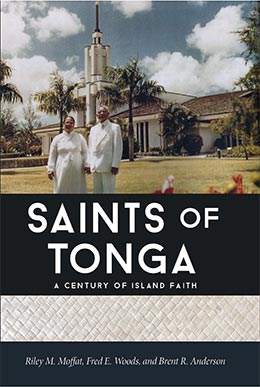Appendix B
Tender Mercies on Niuatoputpu
Riley M. Moffat, Fred E. Woods, and Brent R. Anderson, "Appendix B," in Saints of Tonga (Religious Studies Center, Brigham Young University; Salt Lake City: Deseret Book, 2019), 417–420.
Tender Mercies On Niuatoputapu[1]
Niuatoputapu lies about two hundred miles north of Vava‘u. On September 29, 2009, a major undersea earthquake and tsunami occurred halfway between Niuatoputapu and Samoa. The volcanic island of Tafahi, which lies five miles north of Niuatoputapu, split the energy of the tsunami so that the middle village of Vaipoa was not hit as hard as the villages of Hihifo and Falehau on either side. They were wiped out by thirty- to forty-foot waves that washed everything and everybody inland, leaving some people stranded up in trees.
There was significant destruction and death in Samoa, and President McMurray was very concerned for the safety of the Saints on Niuatoputapu—especially for the two sister missionaries serving there. The next day a reconnaissance flight went up to assess the damage but couldn’t land because of the debris on the little grass airstrip and the loss of all the navigational equipment. The government radioed up for the people to clear the airstrip.
The following day a six-passenger plane carrying Princess Pilolevu flew up to Niuatoputapu to survey the situation, but President McMurray was not able to secure a seat. However, he was able to get the pilot to hand carry a letter to President Lino, the district president on Niuatoputapu, asking him to report on the condition of the missionaries, the members, and the chapels. The pilot brought a reply back and hand delivered it to President McMurray’s counselor, ‘Aisake Tukuafu, that the sisters were all right. Later President McMurray was able to contact the sisters on the police radio and found out that nine people had died, none of whom were members. He learned from President Lino that when they had felt the earthquake, he began alerting the people to run inland. He warned the sisters, but when he came back five minutes later they hadn’t left. They said they had stopped to pray and tell the Lord they were willing to give their lives if necessary. Then President Lino told President McMurray that the sisters, who were “quite fat,” ran up the hill faster than everyone else.
The medical clinic in Hihifo was wiped out, so our little frame chapel was converted into an emergency room and was also used as a morgue.
The following day President McMurray was able to charter a plane to take him, Brother Tukuafu, and some strong elders to help with the cleanup and to bring the sisters back to Tongatapu. The Wesleyans asked if they could send one of their people up as one of the six passengers, and McMurray felt impressed that he should allow that. When their president, Dr. Havea, asked how much they owed, McMurray said, “Nothing,” which they couldn’t believe; they wondered how the Latter-day Saints could arrange this so fast and be so generous and they couldn’t.
The pilot said that because there was no navigational equipment on the island, they could only stay on Niuatoputapu for two hours since he had to get back before dark. But McMurray wanted more time to assess the situation of the members. The Niuatoputapu people begged him to let the sisters stay since they were so cheerful and helpful. They were the angels of the island who had cared for the dead by dressing the bodies for burial and preparing for the funerals.
When they had landed, one of the plane’s two tires popped. The pilot was able to take off without any passengers to fly to Vava‘u for repairs. This meant McMurray and Tukuafu were able to stay overnight, but they had to sleep on the floor in their clothes. This same thing had happened years before when Elder Matthew Cowley stopped on Aitutaki in the Cook Islands for a two-hour stop. He wanted to stay longer to visit with the members, but the tire on the DC-3 went flat when they landed, so he was able to stay overnight with the Saints there.
In a testimony meeting the next day President McMurray promised the Saints, under the inspiration of the Spirit, that if they were faithful, things on the island would be better than before. He said that they needed to be the ones giving comfort and encouragement. He was brought to tears when one single mother with young children testified that the Lord had not abandoned them even though she had lost everything except the clothes they were wearing.
Back on Tongatapu the priesthood leaders met to consider how to help the people on Niuatoputapu. They decided to ask the members to donate food, clothing, and bedding. A short message went out on the radio at 10:00 p.m. for members to take their donations to their chapels the next morning to be taken to the wharf where a ship donated by New Zealand would take the donations up to Niuatoputapu. The next morning trucks overflowing with donations began showing up at the wharf. They lined up, and missionaries formed a line to unload the trucks and pass the donations into the warehouse the government had prepared. The government officials were flabbergasted as the warehouse was filled and they had to go find another one. They never dreamed they’d have that kind of response from one short radio announcement. They found a big military warehouse and filled that one too.
This tragedy on Niuatoputapu demonstrated how the Lord watches over and blesses those that love and serve him.
Notes
[1] Based on interviews with Lynn McMurray and ‘Aisake Tukuafu by Brent Anderson and Riley Moffat.
